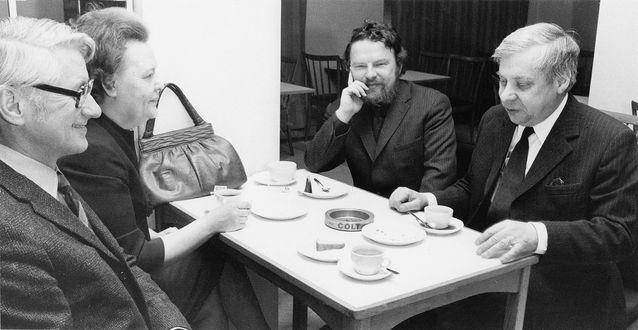Annamari Sarajas
Born October 12, 1923, Nivala. Died January 3, 1985, Helsinki
Master of Arts 1948, Licentiate 1956, PhD 1957, University of Helsinki
Docent in literary history 1957–66
Editorial secretary 1949–50, Näköala
Publication officer 1948–56, Werner Söderström Oy
Editor in chief 1963–64, editorial board member 1965–68, Valvoja
Arts editor 1957–61, head of culture 1965–66, Uusi Suomi
Senior research fellow 1962–64, National Research Council of the Humanities
Research associate in aesthetics and modern literature 1956–60, Professor extraordinary 1967–68, professor of Finnish literature 1968–85, University of Helsinki
Board member 1946, Student Union of the University of Helsinki
Board member 1947–48, National Union of University Students in Finland (SYL)
Board member, vice chairman 1973–80, literature committee chairman 1980–, Finnish Literature Society
Member 1968–77, Supervisory Board of the Finnish Cultural Foundation
Member 1974–, Finnish Academy of Science and Letters
Works:
Suomen kansanrunouden tuntemus 1500–1700 -lukujen kirjallisuudessa (‘Knowledge of Finnish folk poetry in 16th to 17th century literature,’ doctoral dissertation, 1956).
Elämän meri (‘The sea of life,’ 1961)
Viimeiset romantikot (‘The last romantics,’ 1962)
Pohjoisen Suomen kuvaajia (‘Depicters of northern Finland’) in the book Suomen kirjallisuus V (‘Finnish literature V,’ 1965)
Suomalaista proosaa Lehtosesta Sillanpäähän (‘Finnish prose from Lehtonen to Sillanpää,’ 1966)
Tunnuskuvia: Suomen ja Venäjän kirjallisen realismin kosketuskohtia (‘Symbols: points of contact between Finnish and Russian literary realism,’ 1968)
Lumituisku - venäläinen aihelma (‘The blizzard – a Russian motif,’ 1970)
Orfeus nukkuu (‘Orpheus sleeps,’ 1980)
Photo: SKS
Written by Tiia Niemelä
Translated by Matthew Billington

